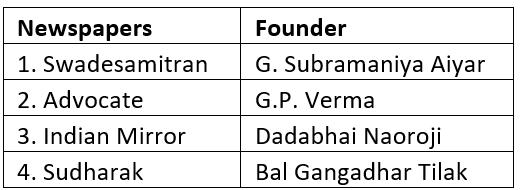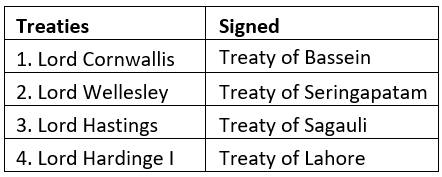Test: History - 4 - UPSC MCQ
30 Questions MCQ Test - Test: History - 4
With reference to the difference between Civil Disobedience Movement and Non- Cooperation Movement, consider the following statements:
The Civil Disobedience Movement had the objective of Purna Swaraj, while Non- Cooperation Movement had the objective of Swaraj.
Muslim participation was relatively lesser during the Non-Cooperation Movement when compared to the Civil Disobedience Movement.
Which of the statements given above is/are correct?
The Civil Disobedience Movement had the objective of Purna Swaraj, while Non- Cooperation Movement had the objective of Swaraj.
Muslim participation was relatively lesser during the Non-Cooperation Movement when compared to the Civil Disobedience Movement.
Consider the following statements:
1. In 1863, Satyendra Prasad Sinha became the first Indian to qualify for the Indian Civil Service.
2. The Indian Police Act, 1861, created a setup for an All India Police.
3. The 1853 Charter Act ended the Company’s patronage, enjoining recruitment to be through an open competition.
Which of the statements given above is/are Correct?
Consider the following statements about the judicial reforms under William Bentinck:
1. He abolished the District Faujdari Courts and established 4 circuit courts at Calcutta, Dacca, Murshidabad and Patna.
2. Sadar Diwani Adalat and Sadar Nizamat Adalat were set up at Allahabad.
3. In the Supreme Court, English language replaced the use of vernacular languages.
Which of the statements given above is/are not Correct?
Consider the following statements:
1. The Bengal gazette, started by James Augustus Hickey in 1780, was the first newspaper in the vernacular language in India.
2. Bal Gangadhar Tilak became the first Indian journalist to be imprisoned for his fight for freedom of press.
Which of the statements given above is/are Correct?
Which of the following sets of pair(s) is/are correctly matched?

Select the correct answer using the code given Below:
Which Union Ministry identified and published poems, writings and publications that were banned by the British Government?
Arrange the following events chronologically:
1. Establishment of Sanskrit College by Jonathan Duncan
2. Establishment of Calcutta Madrasah
3. Censorship of Press Act
4. Foundation of the Asiatic Society of Bengal
Select the correct answer using the code given Below:
Consider the following regarding the Wood’s Despatch (1854):
1. It suggested educating only a small section of upper and middle classes in line with Macaulay’s minutes.
2. It recommended English as the medium of instruction for higher studies and vernaculars at school level.
3. It laid stress on female and vocational education, and on teachers’ training.
Which of the statements given above is/are Correct?
Which of the following statements is/are not correct regarding the early nationalists:
1. They supported foreign capital investment in the country to support industrialization.
2. The drain theory for the first time, was put forward by Romesh Chandra Dutt in The Economic History of India.
3. The economic drain took the form of an excess of exports over imports.
Select the correct answer using the code given Below:
With reference to labour legislations in British India, consider the following statements:
1. The First-ever demand for regulation of the condition of workers in factories in India came from the moderate leaders.
2. These laws did not apply to British-owned tea and coffee plantations.
Which of the statements given above is/are Correct?
Arrange the following events into chronological order
1. The Communist Party of India (CPI) was formed in Tashkent by M.N. Roy.
2. Hindustan Republican Association/Army was founded in Kanpur by Ram Prasad Bismil and others.
3. Chittagong Armoury Raid was conducted under the banner of Indian Republican Army- Chittagong Branch led by Surya Sen.
4. Bhagat Singh, Rajguru and Sukhdev were Hanged.
Select the correct answer using the code given Below:
Which of the following states introduced compulsory primary education throughout its territories in 1906:
In which of the following movements, Gandhi ji act as a mass leader?
1. Bardoli Satyagraha
2. Champaran Satyagraha
3. Kheda Satyagraha
4. Ahmedabad Mill Strike
Select the correct answer from the code given Below:
Netaji Subhash Chandra Bose Island, which was seen in the news recently, is located in which state/UT?
With reference to Jyotiba Phule, consider the following statements:
1. He started the first girl’s school at Poona.
2. Though he campaigned against upper caste domination, he believed in the Vedic supremacy.
Which of the statements given above is/are Correct?
Who among the following was associated with Indian National Liberal Federation:
1. Surendranath Banerjea
2. Tej Bahadur Sapru
3. Pherozeshah Mehta
Select the correct answer using the code given Below
Consider the following statements:
1. Jinnah left congress due to the congress support for the Khilafat Non-Cooperation Movement.
2. Bipinchandra Pal and Annie beasant didn’t agree with the Gandhian program of Non- cooperation.
Which of the statement(s) given above is/are Correct?
Which country topped the medal tally of the ‘2022 World Athletics Championship’?
The Indian Universities Act brought in by Lord Curzon achieved which of the following Objectives?
Which of the following events occurred during Lord William Bentinck’s period?
1. Third Maratha War
2. Suppression of thuggee
3. Treaty of ‘perpetual friendship’ with Ranjeet Singh
Select the correct answer using the code given Below:
Which of the following sets of pair(s) is/are correctly matched?

Select the correct answer using the code given below:
With reference to Hindustan Republican Association, consider the following statements:
1. It was founded by Ram Prasad Bismil.
2. Its aim was to organise an armed revolution against the colonial government.
Which of the statement(s) given above is/are Correct?
Which of the following events occurred during the rule of Governor General Lord Dalhousie:
1. Wood’s education dispatch.
2. Telegraph and postal reforms.
3. Establishment of three universities in Calcutta, Madras and Bombay.
4. Widow Remarriage act.
Select the correct answer using the code given Below:
Consider the following statements:
1. Bahadur Shah Zafar got convicted for his participation in the 1857 revolt and was exiled to Japan.
2. Shah Nawaz Khan and Subhash Chandra Bose were among the accused under INA trials in 1945.
Which of the statement(s) given above is/are Correct?
Consider the following statements:
1. Swarajist opposed the entry of Indian leaders into the colonial legislative councils.
2. No-Changers wanted to end the Boycott and the Non-Cooperation Movement.
Which of the statements given above is/are Correct?
Consider the following statements with reference to Jallianwala Bagh Massacre:
1. People were protesting at Jallianwala Bagh against the arrest of M.K Gandhi.
2. Rabindranath Tagore renounced his Knighthood after this massacre.
3. Hunter Commission was formed to investigate the Jallianwala Bagh Massacre.
Which of the statements given above is/are Correct?















